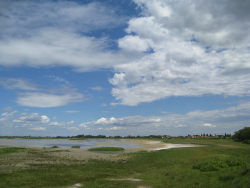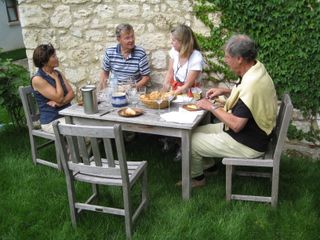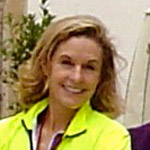Last month, while my husband and I were visiting Vienna, we spent a glorious day with Austrian friends in Burgenland, Austria’s version of Napa and Sonoma.
 In this part of the world, just an hour by car from Vienna, rolling hills of neat, tidy vines share space with the unusual Neusiedlersee or Lake Neusiedler. This long, narrow lake, which runs from Austria into Hungary on its southernmost tip, is very shallow and ringed by thick reeds and desolate salt marches that are home to an amazing (and protected) community of birds.
In this part of the world, just an hour by car from Vienna, rolling hills of neat, tidy vines share space with the unusual Neusiedlersee or Lake Neusiedler. This long, narrow lake, which runs from Austria into Hungary on its southernmost tip, is very shallow and ringed by thick reeds and desolate salt marches that are home to an amazing (and protected) community of birds.
We rented bikes at Radsport Waldherr in the little town of Podersdorf, and set out on a nearly-deserted road that, alternatively, hugged the lake and meandered through fields and marshes, until we found ourselves in the border town of Illmitz. Along the way we stopped to climb into some of the old, wooden “blinds” used for viewing the birds through telescopes.
In early afternoon we returned the bikes and drove to the northwestern banks of the Lake where some of Austria’s best wines are produced.
 Herr Jost Höpler greeted us at his home in the town of Winden. Stepping through an ordinary front door, we found ourselves in an enchanting courtyard covered in glistening grass and surrounded on four sides by centuries-old barns and ivy-covered walls. Höpler had “set” an old wooden table for us and our friends -- with a platter of meats and cheeses, breads, waters and about a dozen of his wines to taste.
Herr Jost Höpler greeted us at his home in the town of Winden. Stepping through an ordinary front door, we found ourselves in an enchanting courtyard covered in glistening grass and surrounded on four sides by centuries-old barns and ivy-covered walls. Höpler had “set” an old wooden table for us and our friends -- with a platter of meats and cheeses, breads, waters and about a dozen of his wines to taste.
Jost Höpler is the force behind the Höpler wine label. Though the family has been involved in wine for generations, it was the affable, hard-working, well-educated (he trained in France, Australia and Italy) Jost who turned the name into a respected household word in Austria and beyond in the late ‘80s.
That was a period of great growth for Austrian wine. A huge scandal in the early ‘80s, involving the tainting of wines with a chemical similar to auto anti-freeze, had just about decimated the country’s wine industry. Höpler and others moved into the void. Today, Austria has some of the strictest government regulations in the world, and a burgeoning group of passionate, knowledgeable winemakers determined to clear their country’s name.
 One of those is Christof Höpler, Jost’s 33-year-old son who today oversees the winemaking operation, leaving “Dad” to develop export opportunities and handle visiting journalists.
One of those is Christof Höpler, Jost’s 33-year-old son who today oversees the winemaking operation, leaving “Dad” to develop export opportunities and handle visiting journalists.
Christof is attempting to take the company to a new level by expanding the number of varietals produced (Höpler currently produces about 25,000 cases per year) and marketing overseas. (Many Höpler wines are available in Southern California, including at WineSellar/Brasserie in San Diego. The Web site Snooth also offers an excellent selection.)
All Höpler wines, red and white, are in the same Bordeaux-style bottle, and virtually all have the same elegant label (designed by Jost’s wife, an architect). Höpler says that the simplicity and convenience of having one shape bottle – necessitating one bottling machine, one type of carton, one size label, etc. – allows him to price the wine better for the consumer.
The first wine we tasted was one of my favorites of the afternoon – a crisp, aromatic, delicious Grüner Veltliner. (Pronounced GROO-ner FEHLT-leener, it’s one of the most readily available Austrian wines in the U.S.) The Höpler version is a remarkably versatile partner….to meats, cheese, tomatoes, seafood, or simply a seat in the sunshine. It usually costs about $12.
I also loved the Zweigelt (see my earlier blog post) we tasted. Made from a grape that’s a hybrid of Blaufränkische and St Laurent, it’s an appealing blend of the former’s fine structure and depth, and the latter’s rich ruby color, subtle flavor and elegance. In the U.S. Zweigelt prices start at about 10 bucks a bottle. (Jost Höpler is second from the left in this photo.)
We were impressed with the Pinot Noir ’05 and the multi-faceted Cab-Merlot mix. But it was the fairly new K7 that really piqued our interest and our tastebuds. Created by son Christof for what he calls a young, sophisticated, cosmopolitan audience, it’s a toothsome blend of Syrah, Blaufränkische and Cabernet Sauvignon. It’s fruity and fragrant, earthy, easy to drink yet with plenty going on if you’re into analyzing and expounding. The label is unique; so’s the trendy glass “cork.”(More about glass corks in a future post.)
Our Burgenland adventure was a successful one. We enjoyed the fresh air and exercise, saw a new part of the world, spent valuable time with old friends, and discovered a new house of wine that offers value, versatility and vibrant flavors.

Luckily I read your blog, like your blog, this is the one I've been worried, thank you.
Posted by: Ajf 4 | July 04, 2010 at 07:49 PM